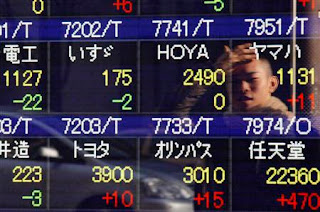Tuesday, January 5, 2010
Asia exits crisis but risk of unrest lingers
Tuesday, January 05, 2010
SINGAPORE: Asia is leading the world out of global recession, but the financial crisis may yet have a dangerous sting in the tail the risk of social unrest as unemployment and inequality rise even as economies recover.
Fears of widespread unrest last year failed to materialise, and most Asian economies are now posting impressive growth. But unemployment is a lagging indicator, and many political risk consultancies are warning that 2010 may hold nasty surprises.
“Although we maintain that the crisis has already inflicted its deepest wounds, its impact will continue to be felt throughout 2010,” the Economist Intelligence Unit said in a report.
The main downside risks to economic stability this year include asset price bubbles, deflationary pressures, and the danger of “an increase in the frequency and intensity of social and political unrest, given increased unemployment, weak growth and impending fiscal austerity measures in many countries,” the EIU said.
Much of the risk is concentrated in Asia. The EIU rates China in the “high risk” category for social unrest in 2010, upgraded from “moderate” risk in 2009. Also in the high risk category are Thailand, Indonesia, the Philippines, Sri Lanka, Cambodia, Bangladesh and North Korea.
But unrest does not necessarily lead to market meltdown. The key question is whether violence is widespread enough to threaten major political upheaval or to significantly disrupt economic activity. Viewed in these terms, China is less of a risk, but Thailand and the Korean peninsula could be flashpoints for 2010.
The single most worrying political risk for investors in Asia is that an eruption of unrest in China destabilises the country and undermines its crucial role as an engine of global economic growth. This would not only cause a major sell-off of Chinese assets, it would undermine markets worldwide. But most analysts rate this risk as extremely low in the coming year.
The Chinese Academy of Social Sciences last month said China had seen unprecedented levels of social conflict in 2009.
But crucially, unrest has almost always been fueled by local grievances and directed at local officials, rather than challenging the legitimacy of the central government. And ethnic unrest in Xinjiang and Tibet never reached a level where it was a major threat to national cohesiveness and a worry for investors.
There is little doubt that 2010 will see multiple outbreaks of mass unrest in China. Tens of thousands of “mass incidents” are reported annually and the trend was moving sharply upwards even before the economic slowdown.
Unemployment in China, though officially at 4.3 per cent for urban jobless, is estimated by analysts to be much higher given the tens of millions of migrant workers. Income inequality is also growing the Chinese Academy of Social Sciences expects the income of urban residents to grow 10 percent in 2010 versus just 6 per cent for the rural poor.
The government is clearly worried about the dangers of a mass movement emerging last month it jailed its most prominent dissident, Liu Xiaobo, to 11 years in jail for campaigning for political freedoms. But so far there is no evidence of widespread popular anger towards the government.
While protests remain localised, investors need not worry unduly about China unrest.
Elsewhere in Asia, unrest is a greater concern for markets.
Thailand is a particular worry. It was mired in an intractable political conflict, broadly between urban elites and the impoverished rural poor, even before the global financial crisis battered the country’s economy.
“Thailand is least comfortable politically,” Standard Chartered strategists wrote in their 2010 outlook for Asia.
“The combination of a weak, effectively unelected government facing sometimes violent street protests and a troublesome former premier hovering nearby is a recipe for major uncertainty.
“Should the health of the revered king worsen again, the situation could become even more tense and threaten the sovereign rating. Confidence would suffer, foreign direct investment inflows could be deterred, and existing high levels of excess capacity would increase, dragging growth lower.”
North Korea is a wild card. Kim Jong-il’s regime has for years been defying analysts’ predictions of its imminent demise.
Information is scarce but the North’s economy is widely believed to be going from bad to worse. Although Pyongyang’s announcement it will return to nuclear disarmament talks should get more aid flowing, there are increasing signs of strain. A sudden currency redenomination late last year added to the hardship of many North Koreans, and there were reports of rare public protests following the move. With Kim’s health also in doubt, the risk of sudden major upheaval cannot be discounted.
An implosion of the regime is a key political risk for the region not just because it would increase the danger that an unstable North Korea could launch an attack on its neighbours, but also because political collapse could lead to the sudden reunification of the peninsula, with heavy economic costs.
Analysts say that North Korea political risk is so difficult to quantify that it is unlikely to be properly priced in, meaning South Korean markets could dive if the Pyongyang regime wobbles.
A final unrest risk is India. As with China, outbreaks of violence are common in Asia’s other emerging superpower, and generally are not of major concern to investors.
But Indian asset prices rallied sharply in 2009 on hopes that the surprisingly strong mandate won by the Congress party in last year’s election would allow it to power ahead with economic reforms. Progress has been considerably slower than many investors had expected, and their optimistic forecasts may have to be revised. In November, tens of thousands of farmers protesting about low state sugarcane prices blockaded India’s parliament and forced the postponement of the winter legislative session.
Subscribe to:
Post Comments (Atom)

No comments:
Post a Comment